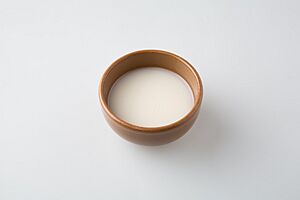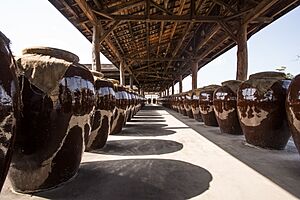Makgeolli facts for kids

A bowl of makgeolli
|
|
| Type | Rice wine |
|---|---|
| Country of origin | Korea |
| Region of origin | East Asia |
| Alcohol by volume | 6–9% |
| Color | Milky, off-white |
| Ingredients | Rice, nuruk |
| Related products | Cheongju, nigori, choujiu, zutho |
| Korean name | |
| Hangul | |
|---|---|
| Revised Romanization | Makgeolli |
| McCune–Reischauer | Makkŏlli |
| Opaque wine | |
| Hangul | |
| Hanja | |
| Revised Romanization | Takju |
| McCune–Reischauer | T'akchu |
| Farmer's wine | |
| Hangul | |
| Hanja | |
| Revised Romanization | Nongju |
| McCune–Reischauer | Nongju |
Makgeolli (Korean: 막걸리; lit. raw rice wine) is a traditional Korean drink. It is a milky, off-white rice wine that is slightly bubbly. It tastes a bit sweet, tangy, and sometimes a little bitter. Tiny bits of sediment make it look cloudy. Makgeolli has a low alcohol content, usually between six and nine percent. Because of this, it's often seen as a drink to share with friends and family.
In Korea, much of the makgeolli is not pasteurized. This means it's not heated to kill germs, so it keeps changing and getting better in the bottle. This fresh "draft" makgeolli doesn't last long. Because of this, makgeolli that is sent to other countries is often pasteurized. This process makes it last longer but can change some of its flavors. Recently, people have started adding fruits like strawberries and bananas to makgeolli to create new flavors.
Contents
What's in a Name?
The name makgeolli (막걸리) comes from two Korean words. Mak (막) means "roughly" or "carelessly." Georeu- (거르-) means "to strain" or "to filter." So, makgeolli means something like "roughly strained."
Because it looks cloudy, makgeolli is also called takju (탁주). This means "opaque wine." This is different from cheongju (청주), which is a "clear wine." Another name for makgeolli is nongju (농주). This means "farmer's wine," showing that it was very popular among farmers.
Japanese Name
In 2009, Korean companies in Japan started selling makgeolli using the name makkori. This is how the word makgeolli sounds in Japanese. Later, some Japanese sake companies also began making cloudy rice wines called makkori. This caused some worry in Korea. People were concerned that makgeolli might be mistakenly seen as a traditional Japanese drink instead of Korean. This had happened before with kimchi, where a similar Japanese version caused confusion.
A Look Back in Time
Makgeolli is the oldest alcoholic drink in Korea. People have been making rice wine since the Three Kingdoms era. This period was from the 1st century BCE to the 7th century CE. Ancient Korean books mention rice wine being enjoyed by kings and people during these times. For example, a 13th-century book called Jewang ungi talks about rice wine during the time of King Dongmyeong.
Other old records also mention rice wine in Korea. The book Samguk yusa from the Goryeo period talks about making "cloudy rice wine" in the kingdom of Silla in 661. A Chinese book called Sānguózhì noted that Goguryeo Koreans were good at making fermented foods like wine. A Japanese book, Kojiki, mentions a man from Baekje teaching how to brew wine.
During the Goryeo dynasty, makgeolli was sometimes called ihwa-ju (이화주). This means "pear blossom alcohol." It was made when pear trees were blooming. For many centuries, makgeolli was made at home. It was known as a "farmer's wine" because it was a common drink for people working in the countryside.
When Korea was under Japanese rule, the government made new rules. They introduced a system where people needed a license to make alcohol. Even making it for yourself was taxed. By 1934, making alcohol at home was banned.
In the 1960s and 1970s, makgeolli was the most popular alcoholic drink in South Korea. However, its popularity started to drop in the 1970s as other drinks became available. Also, due to food shortages, the government banned using rice to make makgeolli. Instead, it was made with wheat flour and corn. This made the quality of makgeolli worse. Because it was seen as cheap and old-fashioned, many companies started making it in large amounts. They often used different fermentation methods instead of the traditional ones. They also diluted it with water.
In the 21st century, makgeolli became popular again, especially in cities and among younger people. People became more interested in its health benefits and low alcohol content. There was also a growing interest in traditional Korean culture. Makgeolli is still quite affordable. A bottle costs about ₩1,200 (around $1 USD). Some special, high-quality makgeolli is also made using old traditional methods without extra ingredients. In 2017, there were at least 700 small breweries making makgeolli in South Korea.
How Makgeolli is Made
Makgeolli is made from rice using something called nuruk. Nuruk is a special dry cake made from grains. It's left to ferment so that molds grow on it. These molds create enzymes that break down the starches in the rice into sugar. Then, yeast uses this sugar to make alcohol through a process called fermentation. Different types of nuruk, made from rice, wheat, or barley, can give makgeolli different flavors.
To make makgeolli, steamed rice, nuruk, and sometimes other flavors like maize, chestnuts, fruits, herbs, or flowers are mixed together. This mixture is then left to ferment in onggi. These are special clay pots that allow air to pass through them. They are also used for making kimchi and soy sauce.
The brewing process has two main steps. First, a "seed mash" is made to get the yeast and enzymes active. Then, the "main mash" is created, where the flavors develop as the rice nutrients change. The main fermentation usually lasts about a week.
Makgeolli tastes best when it's fresh, usually a week or two after it's made. When it's fresh, it's milder and creamier. Over time, it gets a stronger taste. After a few months, it can even turn into rice vinegar.
Traditionally, makgeolli was made in one specific way. But now, to appeal to different people and for export, it's made in various ways. Many people also make makgeolli at home.
Commercial Production
Many mass-produced makgeolli use a different kind of fermentation starter instead of traditional nuruk. They are also often diluted with water and have extra ingredients like aspartame. Aspartame makes the drink sweet without adding sugar that would ferment. This helps the drink last longer. Sometimes, flavors like fruit or ginseng are added too.
| Year | Production |
|---|---|
| 2005 | 166,319 kL (5,873,500 cu ft) |
| 2006 | 170,165 kL (6,009,300 cu ft) |
| 2007 | 172,342 kL (6,086,200 cu ft) |
| 2008 | 176,398 kL (6,229,400 cu ft) |
| 2009 | 260,694 kL (9,206,300 cu ft) |
| 2010 | 412,269 kL (14,559,100 cu ft) |
| 2011 | 458,198 kL (16,181,100 cu ft) |
| 2012 | 448,046 kL (15,822,600 cu ft) |
| 2013 | 426,216 kL (15,051,700 cu ft) |
| 2014 | 430,896 kL (15,216,900 cu ft) |
| 2015 | 416,046 kL (14,692,500 cu ft) |
Famous Makgeolli by Region
How Makgeolli is Enjoyed
Makgeolli is usually served cold. It comes in a bottle or a pottery bowl with a ladle. Before drinking, you should stir it with the ladle. Or, if it's in a bottle, gently flip it upside down a few times with the cap on. This mixes the cloudy sediment that settles at the bottom. Then, it's poured into small bowls, not cups, for drinking.
Makgeolli is often eaten with buchimgae, which are Korean pancakes. Examples include pajeon (made with scallions) and bindae-tteok (made with mung beans and pork). Eating makgeolli with these pancakes is a tradition often linked to rainy days. One idea is that the sound of rain is like the sizzling sound of pancakes cooking. Another idea is that farmers would make pancakes and drink makgeolli when it rained and they couldn't work.
You can also mix makgeolli with ice and fruits like mango or pineapple to make fruit cocktails. Mixing it with saida (a lemon-lime drink) makes a simple cocktail called maksa. If you mix makgeolli with kkul (honey), it's called kkul-makgeolli.
Because of the tiny living things (microorganisms) in it from fermentation, makgeolli is a probiotic drink. It has good bacteria like Lactobacillus, along with vitamins, amino acids, and fiber. It's thought to help with digestion and energy.
Similar Drinks
Dongdong-ju is a drink very similar to makgeolli. It's a bit creamier and has whole rice grains floating in it. The name dongdong sounds like something floating. Ihwa-ju ("pear-blossom wine") is named because it's made when pear trees bloom. It's often so thick you can eat it with a spoon. Dansul ("sweet wine") is a sweeter version that is only partly fermented.
The Tibetan drink Chhaang is also very similar. It looks cloudy and milky, with rice sediments. In Nepal, where chaang is popular, Korean bottled makgeolli is sometimes sold as chaang.
Chinese choujiu and Japanese nigori are also rice wines that are similar to makgeolli.
Images for kids
See also
 In Spanish: Makgeolli para niños
In Spanish: Makgeolli para niños
- Nigori – Japanese version of Makgeolli
- Choujiu – Chinese version of Makgeolli
- Zutho – Naga version of Makgeolli
- Cheongju
- List of rice beverages
- Korean alcoholic beverages






